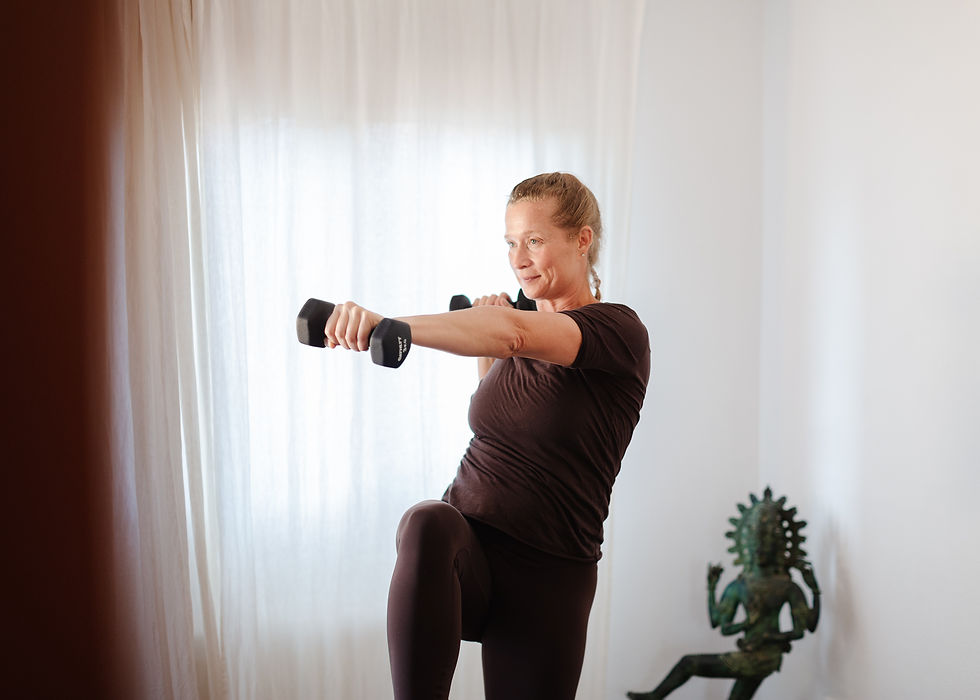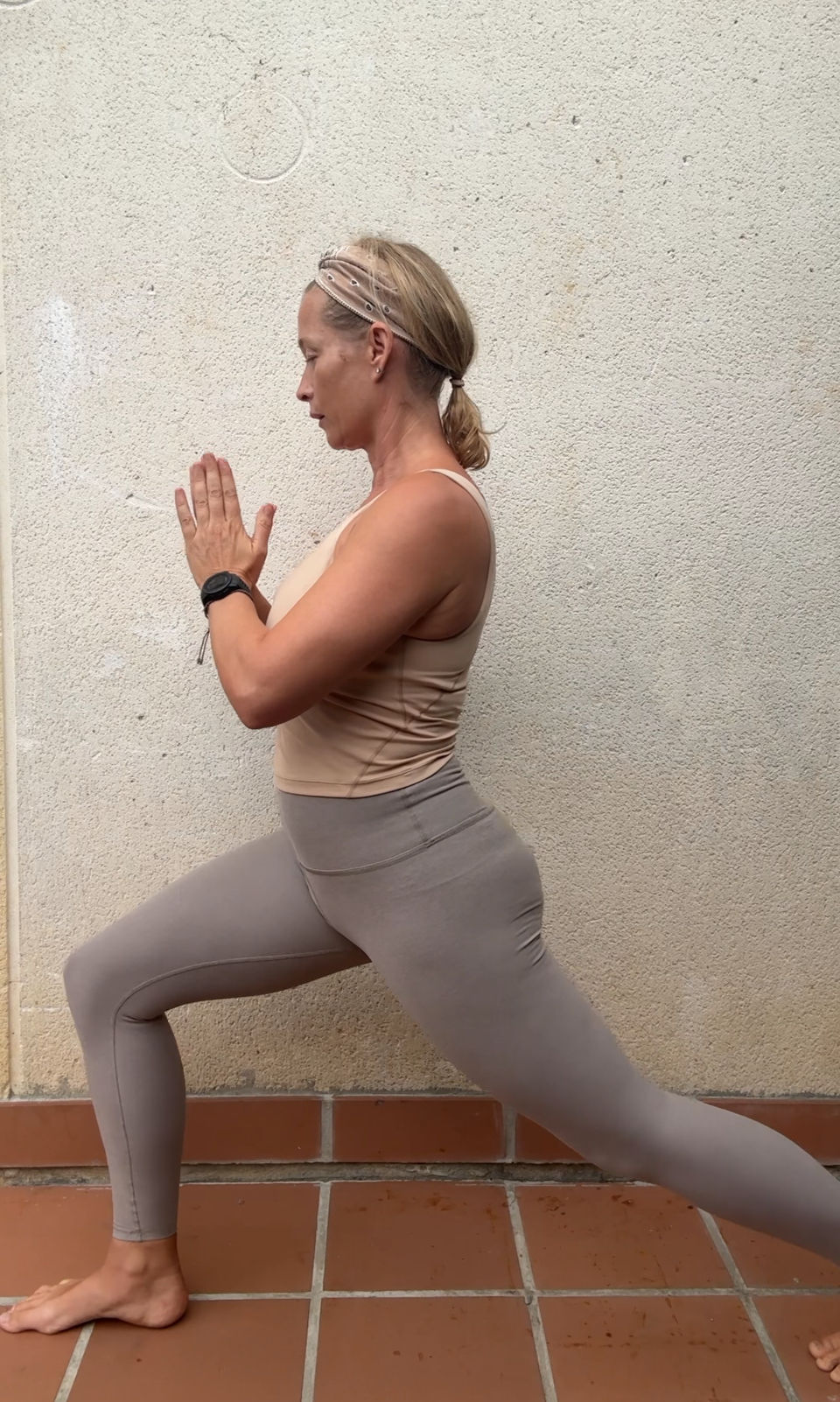Why Women Over 40 Should Train Differently: My Journey and the Birth of SoulSculpt
- Shaini Verdon
- Sep 29
- 6 min read

From Gym to Yoga to SoulSculpt: My Training Evolution
When I look back at my training journey, it feels like I’ve lived several lives in one body. In my teens and twenties, I thrived on intensity — kickboxing, football (soccer) at a high level, hours spent in the gym. I even studied personal training to deepen my knowledge.
But when I began travelling in my mid-twenties, my focus shifted. Surfing and yoga took centre stage, and for nearly two decades I immersed myself in both practices. Surfing gave me freedom and connection to nature, while yoga offered depth, discipline, and alignment.
Then, just before my Iyengar yoga exam, my body started sending signals: persistent aches, stubborn pains. Add to that becoming a mother later in life, and I realised that yoga alone was no longer enough to keep me strong, resilient, and pain-free. My body needed more.
So I returned to my roots in fitness — but with a difference. I didn’t leave yoga and Pilates behind. Instead, I blended everything I had learned. The result is SoulSculpt: a method born from strength training, mobility, alignment, balance, and the mindful presence of yoga and Pilates.
Why Women Over 40 Should Train Differently
As women, our bodies change profoundly during perimenopause and beyond. Hormonal shifts affect everything from bone density to muscle mass, energy levels, and even how we recover from stress. What worked in our twenties and thirties doesn’t necessarily serve us after 40.
Here’s what the science shows:
Bone density declines as estrogen drops, increasing osteoporosis risk.
Muscle mass (sarcopenia) begins to decline, lowering metabolism and strength.
Balance and mobility become critical for preventing injuries and maintaining independence.
Recovery needs shift — long endurance sessions can raise cortisol and leave us depleted.
This doesn’t mean we can’t train hard. It means we need to train smarter. Progressive overload in strength training, balanced with mobility, breath, and recovery, is the formula for women over 40 to thrive.
Progressive Overload for Strength and Bone Health
Strength training isn’t optional anymore — it’s essential. Progressive overload (gradually increasing the demand placed on muscles) helps us:
Build and maintain lean muscle mass.
Strengthen bones and protect against osteoporosis.
Support metabolism and body composition.
It’s not about lifting the heaviest weights possible; it’s about building strength with intelligence, form, and consistency.
Beyond Strength: Metabolism, Weight, and the “Bulk” Myth
One of the biggest misconceptions I hear from women is: “If I start lifting heavier, won’t I get bulky?” The truth is, it’s actually very difficult for women to build bulky muscle — we simply don’t have the testosterone levels for it. What strength training gives us instead is lean, functional muscle that supports everything we do in life.
And the benefits go far beyond appearances. As we move through perimenopause and beyond, our bodies change on a cellular level:
Metabolism slows down naturally with age, partly due to muscle loss. Metabolism is the process by which your body turns food into energy. When it slows, you can eat the same way you always have, but end up storing more of it as fat. Strength training helps by keeping your muscles active, which in turn keeps your metabolism higher.
Insulin sensitivity declines. This means your body doesn’t handle blood sugar as efficiently, making it easier to store fat and harder to regulate energy. Resistance training improves this by helping your muscles pull sugar out of the bloodstream and use it for fuel.
Fat oxidation capacity drops. Estrogen plays a role in how well women use fat as fuel. As levels decline, the body tends to rely more on carbohydrates for energy, especially during exercise. This can make longer endurance sessions feel harder and less effective. (Read more here on how to train cardio differently after 40+) Strength training helps here by improving mitochondrial function — the energy powerhouses in your cells — and by increasing lean muscle mass, which raises your overall ability to burn both fat and carbohydrates more efficiently. In other words: even though fat oxidation declines naturally, resistance training keeps your body metabolically flexible. (Ps. This doesn’t mean we should load up on carbs — or cut them out — but it does also mean we need to be more mindful about the quality of the carbohydrates we eat and pair them with protein and fibre for better balance. Read more here about eating for hormonal health.)
So while aesthetics often improve with strength training — muscle creates shape and definition, while also supporting fat metabolism — the bigger picture is this: we’re training for life, not just looks. At 40, 50, 70 and beyond, it’s strength that allows us to move with freedom, independence, and energy.
Balance, Mobility & Proprioception
Strength alone isn’t enough. Balance and mobility matter just as much, especially as we age.
A key concept here is proprioception — the body’s ability to sense its position and movement in space. Good proprioception prevents falls, improves posture, and allows us to move confidently.
The decline of proprioception with age is one reason falls become more common. Training it deliberately — through balance work, mindful movement, and mobility drills — is just as important as lifting weights.
Power, Play & Longevity
One element that often gets overlooked in women’s training is power. Think of it as strength expressed quickly: jumps, sprints, explosive movements. Training power keeps the nervous system sharp, protects reaction time, and translates into real-life vitality — whether that’s catching a wave, running after your child, or simply moving with ease.
Longevity isn’t just about how many years we live, but the quality of those years. Training for strength, balance, mobility, and power ensures that we not only live longer but live better.
The Yoga & Pilates Advantage in Strength Training
Many women who join my classes come from a yoga or Pilates background, and this is a gift.
Years of focusing on alignment, breath, and mindful awareness give them an incredible foundation for strength training. Even if they’ve never heard the word proprioception, they already have it. They know how to engage their body somatically, how to move with control, and how to listen inwardly.
This means they can transition into strength training more smoothly — and often more safely — than those who have only trained in fitness settings. Instead of chasing reps or weight, they bring presence, precision, and quality into their lifting.
This is exactly what SoulSculpt was designed for: bridging mindful movement with intelligent strength training, so women can step into this next chapter of life with resilience and vitality.
What Makes SoulSculpt Different
SoulSculpt is more than just a workout — it’s the result of a lifetime spent exploring movement in all its forms. I started training young, with a strong fitness and gym background, then immersed myself in a deep yoga practice for many years. Later, I added Pilates, surfing, and functional movement into the mix. SoulSculpt brings all of that together — the alignment and awareness of yoga, the core intelligence of Pilates, and the strength and progressive overload of resistance training.
It also comes from lived experience. I’m in my forties myself, moving through perimenopause, and practising these methods in my own body nearly every day. I’ve felt the shifts, done the research, tested the science, and blended it into something that truly works in real life. I’ve done the deep dive, so you don’t have to; all you need to do is show up, practice, and enjoy the benefits.
At its core, SoulSculpt is a method built on:
Pilates & yoga foundations — alignment, breath, mindful presence.
Strength training principles — progressive overload, resistance, functional movement.
Mobility and balance — to keep joints supple and prevent injury.
Form over reps — quality of movement is always the priority.
Whether in online classes, private sessions, or women’s retreats, SoulSculpt is tailored for women 40+. It’s about training with intelligence, not intensity for intensity’s sake.
Training for Longevity as a Woman Over 40
Surfing remains one of my passions, and being able to keep paddling into waves is part of my “why.” So is motherhood. I became a mother at 41, and I want to be the kind of parent who can move freely, playfully, and energetically alongside my daughter as she grows.
That’s what longevity means to me: not just adding years, but adding quality years. And the way we train after 40 is one of the biggest factors in how we get there.
Conclusion
Why should women over 40 train differently? Because our bodies demand it — and because the rewards are greater than ever. Strength, balance, mobility, and power aren’t just about looking fit. They’re about living fully.
That’s the vision behind SoulSculpt: a training method designed for women who want to embrace this phase of life with strength, vitality, and presence.
👉 Ready to experience it yourself? Join me in an online SoulSculpt class, try a free class , a private session, or one of my women’s retreats in Cantabria. Let’s build the strength, mobility, and balance that will carry you through the decades ahead — with quality, joy, and freedom.
With love,
Shaini



Comments